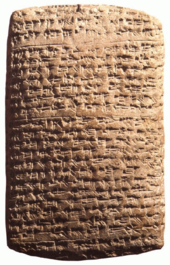Amarna time
The term “ Amarna Period ” is used in the history of ancient Egypt and the ancient Orient to describe a period of the Late Bronze Age there , which began in the 14th and 13th centuries BC. Includes. In Egypt it includes the reigns of the kings ( pharaohs ) Akhenaten and Semenchkare . Akhenaten had founded a new capital (Achet-Aton) in his 6th year of reign near today's Tell el-Amarna (Amarna) in Middle Egypt and worshiped a sun god as the only god with Aten and pursued the memory (in pictures and inscriptions) of other deities, especially that of the ancient god Amun . Akhenaten thus radically broke with many of Egypt's ancient traditions. Many innovations can also be observed in art. Many aspects of the death of the ruler and the time that followed are still unexplained, but there seem to have been conditions similar to civil war. Stabilized conditions only emerged under Haremhab .

The Egyptian site of Tell el-Amarna is named for this period. Since the early 1890s , fellahs found an archive of around 400 clay tablets , which contained parts of the political correspondence of kings Amenophis III. , Akhenaten and Tutankhamun between about 1358 and 1330 BC Document. Since the political system that reflects this correspondence varied from the 15th to the end of the 13th century BC. The term “Amarna period” is now anachronistically applied to this entire epoch.
The diplomatic system, also known as the “Club of the Great Powers” or “Club of the Great Kings”, extended in its east-west extension from western Iran to the Aegean Sea and in its north-south extension from Anatolia to Nubia . This system was supported by the Kassite Babylonia , the Hittite Empire and Egypt , which lasted for the entire epoch. In northern Mesopotamia there was initially the Mitanni Empire, which was replaced by the emerging Central Assyrian Empire in the middle of the 14th century . The eastern border area formed the kingdom of Elam , the western border marked Keftiu ( Crete ) and Tanaja ( Peloponnese or the entire Mycenaean ruled Greek mainland) in Greece. In addition to these large states, there was a large number of city-states , especially in Syria and Palestine , which were in changing relationships of dependency with the great powers.
art
During the Armana period, the so-called Amarna art prevailed in large parts of Egypt . The people were painted with softer features, with round bellies and with overly long necks and faces.
The relief of Nefertiti and Akhenaten are among the most important works of this period.
literature
- Raymond Cohen, Raymond Westbrook (Eds.): Amarna Diplomacy. The Beginnings of International Relations. Johns Hopkins University Press, Baltimore MD et al. 2000, ISBN 0-8018-7103-4 .
- Marc Van de Mieroop : A History of the Ancient Near East. approx. 3000-323 BC . 2nd Edition. Blackwell Publishers, Malden MA et al. 2007, ISBN 978-1-4051-4911-2 , pp. 129-201.
- Amanda H. Podany : Brotherhood of Kings. How International Relations shaped the Ancient Near East. Oxford University Press, Oxford et al. 2010, ISBN 978-0-19-531398-7 . Pp. 189-304.
- Michael E. Habicht : Nefertiti and Akhenaten. The secret of the Amarna mummies. Koehler & Amelang, Leipzig 2011, ISBN 978-3-7338-0381-0 .
- Boaz Stavi: The Reign of Tudhaliya II and Šuppiluliuma I. The Contribution of the Hittite Documentation to a Reconstruction of the Amarna Age. Universitätsverlag Winter, Heidelberg 2015, ISBN 978-3-8253-6442-7 .
Individual evidence
- ↑ Amanda H. Podany: Brotherhood of Kings. P. 189.
- ↑ Jürgen von Beckerath : Chronology of the Pharaonic Egypt. von Zabern, Mainz 1997, ISBN 3-8053-2310-7 , pp. 111-114.
- ↑ Thomas F. Tartaron: Maritime Networks in the Mycenaean World , Cambridge University Press 2013, pp. 28ff.
